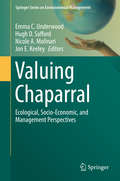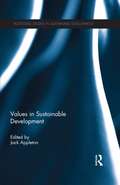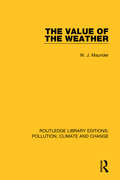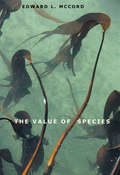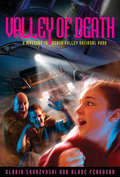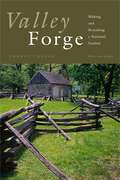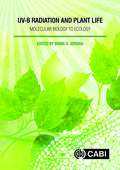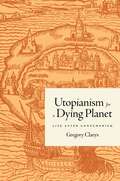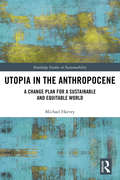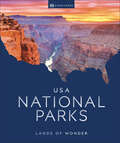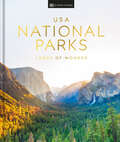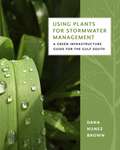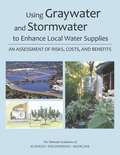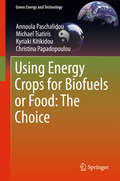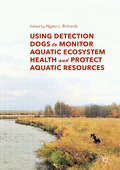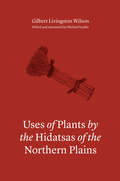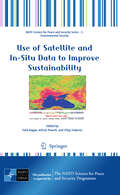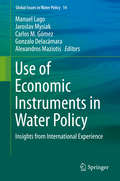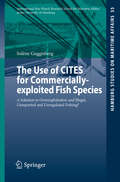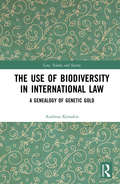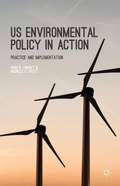- Table View
- List View
Valuing Chaparral: Ecosystem Services And Resource Management (Springer Series On Environmental Management)
by Jon E. Keeley Nicole A. Molinari Hugh D. Safford Emma C. UnderwoodChaparral shrubland ecosystems are an iconic feature of the California landscape, and a highly biodiverse yet highly flammable backdrop to some of the fastest growing urban areas in the United States. Chaparral-type ecosystems are a common element of all of the world’s Mediterranean-type climate regions – of which California is one – yet there is little public appreciation of the intrinsic value and the ecosystem services that these landscapes provide. Valuing Chaparral is a compendium of contributions from experts in chaparral ecology and management, with a focus on the human relationship with chaparral ecosystems. Chapters cover a wide variety of subjects, ranging from biodiversity to ecosystem services like water provision, erosion control, carbon sequestration and recreation; from the history of human interactions with chaparral to current education and conservation efforts; and from chaparral restoration and management to scenarios of the future under changing climate, land use, and human population. Valuing Chaparral will be of interest to resource managers, the research community, policy makers, and the public who live and work in the chaparral dominated landscapes of California and other Mediterranean-type climate regions.
Values in Sustainable Development: Values In Sustainable Development (Routledge Studies in Sustainable Development)
by Jack AppletonTo enhance sustainable development research and practice the values of the researchers, project managers and participants must first be made explicit. Values in Sustainable Development introduces and compares worldviews and values from multiple countries and perspectives, providing a survey of empirical methods available to study environmental values as affected by sustainable development. The first part is methodological, looking at what values are, why they are important, and how to include values in sustainable development. The second part looks at how values differ across social contexts, religions and viewpoints demonstrating how various individuals may value nature from a variety of cultural, social, and religious points of view. The third and final part presents case studies ordered by scale from the individual and community levels through to the national, regional and international levels. These examples show how values can motivate, be incorporated into and be an integral part of the success of a project. This thought-provoking book gives researchers, students and practitioners in sustainable development a wealth of approaches to include values in their research.
The Value of the Weather
by W. J. MaunderOriginally published in 1970, this book brings together the most significant and pertinent associations between man’s economic and social activities, and the variations in the atmospheric environment. Particular emphasis is placed on economic activities and the weather, economic analysis of weather and the benefits and costs of weather knowledge. In addition, some of the sociological, physiological, political, planning and legal aspects of atmospheric resources are discussed.
The Value of Species
by Edward L. MccordWe humans value a great variety of plant and animal species for their usefulness to us. But what is the value--if any--of a species that offers no practical use? In the face of accelerating extinctions across the globe, what ought we to do? Amid this sea of losses, what is our responsibility? How do we assess the value of nonhuman species? In this book, naturalist and philosopher Edward L. McCord explores urgent questions about the destruction of species and provides a new framework for appreciating and defending every form of life. The book draws insights from philosophy, ethics, law, and biology to arrive at a new way of thinking about the value of species to humanity is intellectual: individual species are phenomena of such intellectual moment--so interesting in their own right--that they rise above other values and merit enduring human embrace. The author discusses the threats other species confront and delineates the challenges involved in creating any kind of public instrument to protect species.
Valley of Death
by Gloria Skurzynski Alane FergusonJack can’t believe what he’s hearing. His sister is being held hostage. Whoever snatched Ashley must have been following the Landons as they explored Death Valley National Park. But what do they want with Leesa? When Jack discovers why Leesa is on the run, he is determined to protect her. But how can he do that and save Ashley, too? One thing he knows for sure, failure is not an option.
Valley Forge: Making and Remaking a National Symbol (Keystone Books)
by Lorett TreeseMore than four million people a year visit Valley Forge, one of America's most celebrated historic sites. Here, amid the rolling hills of southeastern Pennsylvania, visitors can pass through the house which served as Washington's Headquarters during the famous winter encampment of 1777–1778. Others picnic and jog in the huge park, complete with monuments, recreated log huts, and modern visitor center, all built to pay tribute to the Valley Forge story. In this lively book, Lorett Treese shows how Valley Forge evolved into the tourist mecca that it is today. In the process, she uses Valley Forge as a means for understanding how Americans view their own past. Treese explores the origins of popular images associated with Valley Forge, such as George Washington kneeling in the snow to seek divine assistance. She places Valley Forge in the context of the historic preservation movement as the site became Pennsylvania's first state park in 1893. She studies its "Era of Monuments" and the movement to "restore" Valley Forge in the spirit of Rockefeller's enormously popular colonial Williamsburg. Treese describes a Valley Forge fraught with controversy over the appropriate appearance and use of a place so revered. One such controversy, the "hot dog war," a brief but intense battle over concession stands, was spawned by Americans' changing perceptions of how a national park was to be used. The volatile Vietnam era prompted the state park commission to establish its "Subcommittee on Sex, Hippies, and Whiskey Swillers" to investigate park regulation infractions. Even today, people differ over exactly what happened at Valley Forge during the winter of 1777–1778. The modern visitor sees the remains of over a century of commemoration, competition, and contention. The result, Treese shows, is a historic site that may reveal more about succeeding history than about Washington's army. This book will give its readers a new way to look at Valley Forge—and all historic sites.
Valenslime
by Joy KellerA young slime scientist's efforts to make a Valentine's Day friend for her slime explode in Valenslime, a clever and funny picture book companion to Joy Keller and Ashley Belote’s Frankenslime.Victoria Franken, slime scientist, loved her slime. And her slime loved her back. Ever since the dark and stormy night when Victoria Franken brought her slime to life, she and Goop have been great friends, but when Valentine's Day rolls around, Victoria comes to the horrifying realization that while she had many friends, Goop only had her. The only solution is for her to make him a new friend. But when Victoria gets bored waiting for lightning to strike twice, things get a bit out of control!
UV-B Radiation and Plant Life
by Brian R. JordanUltraviolet-B radiation (UV-B) has profound effects on plant growth and development, and exposure varies with ozone depletion and across geographic regions, with ecosystem and agricultural consequences. This book deals with large-scale impacts but also how UV-B affects plants at the molecular level is also fascinating, and the UV-B photoreceptor has only recently been characterised. While UV-B radiation can be damaging, it also has a more positive role in plant photomorphogenesis. Consequently UV-B treatments are being developed as innovative approaches to improve horticulture. This book is a timely synthesis of what we know and need to know about UV-B radiation and plants.
Utopianism for a Dying Planet: Life after Consumerism
by Gregory ClaeysHow the utopian tradition offers answers to today’s environmental crisesIn the face of Earth’s environmental breakdown, it is clear that technological innovation alone won’t save our planet. A more radical approach is required, one that involves profound changes in individual and collective behavior. Utopianism for a Dying Planet examines the ways the expansive history of utopian thought, from its origins in ancient Sparta and ideas of the Golden Age through to today's thinkers, can offer moral and imaginative guidance in the face of catastrophe. The utopian tradition, which has been critical of conspicuous consumption and luxurious indulgence, might light a path to a society that emphasizes equality, sociability, and sustainability.Gregory Claeys unfolds his argument through a wide-ranging consideration of utopian literature, social theory, and intentional communities. He defends a realist definition of utopia, focusing on ideas of sociability and belonging as central to utopian narratives. He surveys the development of these themes during the eighteenth and nineteenth centuries before examining twentieth- and twenty-first-century debates about alternatives to consumerism. Claeys contends that the current global warming limit of 1.5C (2.7F) will result in cataclysm if there is no further reduction in the cap. In response, he offers a radical Green New Deal program, which combines ideas from the theory of sociability with proposals to withdraw from fossil fuels and cease reliance on unsustainable commodities.An urgent and comprehensive search for antidotes to our planet’s destruction, Utopianism for a Dying Planet asks for a revival of utopian ideas, not as an escape from reality, but as a powerful means of changing it.
Utopia in the Anthropocene: A Change Plan for a Sustainable and Equitable World (Routledge Studies in Sustainability)
by Michael HarveyUtopia in the Anthropocene takes a cross-disciplinary approach to analyse our current world problems, identify the key resistance to change and take the reader step by step towards a more sustainable, equitable and rewarding world. It presents paradigm-shifting models of economics, political decision-making, business organization and leadership and community life. These are supported by psychological evidence, utopian literature and inspirational changes in history.The Anthropocene is in crisis, because human activity is changing almost everything about life on this planet at an unparalleled pace. Climate change, the environmental emergency, economic inequality, threats to democracy and peace and an onslaught of new technology: these planetwide risks can seem too big to comprehend, let alone manage. Our reckless pursuit of infinite economic growth on a finite planet could even take us towards a global dystopia. As an unprecedented frenzy of change grips the world, the case for utopia is stronger than ever. An effective change plan requires a bold, imaginative vision, practical goals and clarity around the psychological values necessary to bring about a transformation. This book will be of great interest to students and scholars of the environmental humanities, sustainability studies, ecological economics, organizational psychology, politics, utopian philosophy and literature – and all who long for a better world.
USS Bacalao
by J. T. McDaniel Franco G. RovedoJ.T. McDaniel assume o comando com a mão firme de um mestre em sua arte, criando uma representação precisa e fascinante da vida diária a bordo de um submarino de ataque na década de 1940. Do estaleiro do construtor em Connecticut, aos combates velozes no teatro do Pacífico, ao coração trovejante de profundidades explosivas, cada detalhe soa com autenticidade. McDaniel escreve com a precisão técnica de Tom Clancy, o ritmo de Michael DiMercurio e a compreensão humana de Edward L. Beach. Um leitor simplesmente não pode querer mais. O USS Bacalao é a história de um submarino da frota americana da classe Gato desde o pátio da Electric Boat Company na cidade de Groton de pré-guerra, em Connecticut, passando pelos primeiros treinamentos, presenciando o ataque japonês a Pearl Harbor, e atingindo o coração do Império Japonês. De Pearl Harbor a Fremantle, o pequeno barco e sua corajosa tripulação atacam um inimigo determinado e enfrentam a sua própria burocracia para levar a guerra ao inimigo. E, apesar de tudo, Lawrence Miller está lá, subindo lentamente a partir do quarto na lista de oficiais do barco, partindo para uma excursão no comando de um antigo submarino no Alasca e finalmente retornando a Bacalao como seu último oficial comandante. Uma aventura emocionante e verdadeira que encanta aqueles que admiram o mar e seus personagens.
USA National Parks: Lands of Wonder
by DK EyewitnessBreathtaking and awe-inspiring, the USA National Parks never fail to amaze. Distinguished by rust-red canyons, snow-capped peaks and silent forests, they&’re yours to roam. Immerse yourself and your family in these ancient lands, explore their heritage and find out what makes them unique.Whether it&’s your dream to check the Grand Canyon off your bucket list, discover Alaska&’s Denali Park, and explore Florida&’s Everglades, or if you&’re simply seeking inspiration for your next trip to the great outdoors, USA National Parks Lands of Wonder ensures you experience all the American wilderness has to offer. USA National Parks Lands of Wonder truly brings all 62 National Parks to life, celebrating the country&’s most breathtaking landscapes. USA National Parks is your ticket to the trip of a lifetime. Inside USA National Parks you will find: • Inspiring photography throughout that evokes the majesty of the national parks • &‘Focus On&’ sections including features on National Parks throughout each season, best times to visit, and geographical insights • Practical tips on what to enjoy during your trip, including popular hikes, bird-watching tips, and activities for the whole family to enjoy • &‘Did You Know?&’ sections featured throughout to test your knowledge on the culture, history and wildlife of the National Parks you visit • &‘Ways To Explore&’ sections featured throughout to maximize your adventures, offering ideas such as camping, picnicking, hiking, sledging, night-watching and walking • Expert led hike Trails with easy, moderate and challenging options to plan your route ahead of your trip • Covers: Yellowstone, Yosemite, Sequoia, Mount Rainier, Crater Lake, Wind Caves, Mesa Verde, Glacier Rocky Mountain, Lassen Volcanic, Hawai&’i Volcanoes, Denali, Grand Canyon, Zion, Acadia, Hot Springs, Bryce Canyon, Grand Teton, Carlsbad Caverns, Great Smoky Mountains, Shenandoah, Olympic, Kings Canyon, Isle Royale, Mammoth Cave, Big Bend, Everglades, Virgin Islands, Haleakalā, Petrified Forest, Canyonlands, North Cascades, Redwood, Capitol Reef, Arches, Guadalupe Mountains, Voyageurs, Theodore Roosevelt, Badlands, Channel Islands, Biscayne, Katma,i Glacier Bay, Gates of the Arctic, Kenai Fjords, Kobuk Valley, Lake Clark, Wrangell St. Elias, Great Basin, National Park of American Samoa, Dry Tortugas, Death Valley, Saguaro, Joshua Tree, Black Canyon of the Gunnison, Cuyahoga Valley, Congaree, Great Sand Dunes, Pinnacles, Gateway Arch, Indiana Dunes, White Sands Seeking more adventures in the USA? Don&’t forget to check out DK Eyewitness Southwest USA, DK Eyewitness Florida, DK Eyewitness New England, DK Eyewitness Hawaii, DK Eyewitness Pacific Northwest, and DK Eyewitness USA to make the most of your trip and achieve the adventure of a lifetime.About DK Eyewitness: At DK Eyewitness, we believe in the power of discovery. We make it easy for you to explore your dream destinations. DK Eyewitness travel guides have been helping travellers to make the most of their breaks since 1993. Filled with expert advice, striking photography and detailed illustrations, our highly visual DK Eyewitness guides will get you closer to your next adventure. We publish guides to more than 200 destinations, from pocket-sized city guides to comprehensive country guides. Named Top Guidebook Series at the 2020 Wanderlust Reader Travel Awards, we know that wherever you go next, your DK Eyewitness travel guides are the perfect companion.
USA National Parks: Lands of Wonder
by DK EyewitnessThe USA&’s National Parks truly are places of wonder: staggering landscapes of jaw-dropping dimensions and incredible diversity where you can stand on the very edge of civilization.They are the earth&’s breathing spaces, precious places to conserve nature and wildlife for future generations. Explore countless places to hike, camp, climb, swim, and paddle, where you and your family can create lifelong memories of freedom and wide-open spaces.The book contains inspiring narratives reflecting the rich diversity and natural importance of the parks, including their role in conserving wildlife, their intricate ecosystems, and their importance as untamed yet accessible spaces where people love to escape and unwind. In this book, you&’ll discover: -Beautiful photography and inspiring ideas – perfect for planning your next adventure -63 national parks in order of designation, showcasing what makes each one special-Maps, facts and figures, things to do, and when and where to experience it at its bestThe book considers the history of the national parks – the ideas behind their establishment, why they hold a special place in American culture, and why they&’re more relevant than ever today. Celebrate the beauty, history, and cultural importance of America&’s 63 national parks in this revised and updated edition, which features the newest national park, New River Gorge.
Using Supercritical Water Oxidation to Treat Hydrolysate from VX Neutralization
by Committee on Review Evaluation of the Army Chemical Stockpile Disposal ProgramInformation on Using Supercritical Water Oxidation to Treat Hydrolysate from VX Neutralization
Using Plants for Stormwater Management: A Green Infrastructure Guide for the Gulf South
by Dana Nunez BrownThe subtropical climate of the Gulf South supports a varied abundance of flora, and this diversity is sustained by the ample amount of rainwater that characterizes the region. Managing rainwater in a planned environment and mitigating its effect on human habitation can test the skills of even the most seasoned landscape architect or designer. That challenge has never been more acute as increased human demand for natural resources compels professionals and home gardeners alike to seek out sustainable ecological solutions.In this guidebook, Dana Nunez Brown details ways to manage each drop of rainwater where it falls, using a cost-effective and environmentally sensitive approach. Under natural conditions, rainfall primarily percolates into the ground and flows as groundwater until it is absorbed by trees and other vegetation, after which it is evaporated into the atmosphere and the cycle starts anew. Brown identifies plants and techniques that leverage this natural process in order to filter, clean, and slow runoff, a practice known as Low Impact Development. Using Plants for Stormwater Management presents the native ecological communities and plant species of the Gulf South in easy-to-follow sections and diagrams. Information ranging from the productiveness of root structures and the compatibility of plants with local soils to the optimal elevation of specific vegetation and the average dimensions of foliage is represented by graphic icons for quick and easy identification. An accessible and essential resource, this book gives both novices and experts the know-how to harness rainfall and create beautiful, ecologically functioning landscapes.
Using Graywater and Stormwater to Enhance Local Water Supplies: An Assessment of Risks, Costs, and Benefits
by National Academies of Sciences Engineering MedicineChronic and episodic water shortages are becoming common in many regions of the United States, and population growth in water-scarce regions further compounds the challenges. Increasingly, alternative water sources such as graywater-untreated wastewater that does not include water from the toilet but generally includes water from bathroom sinks, showers, bathtubs, clothes washers, and laundry sinks- and stormwater-water from rainfall or snow that can be measured downstream in a pipe, culvert, or stream shortly after the precipitation event-are being viewed as resources to supplement scarce water supplies rather than as waste to be discharged as rapidly as possible. Graywater and stormwater can serve a range of non-potable uses, including irrigation, toilet flushing, washing, and cooling, although treatment may be needed. Stormwater may also be used to recharge groundwater, which may ultimately be tapped for potable use. In addition to providing additional sources of local water supply, harvesting stormwater has many potential benefits, including energy savings, pollution prevention, and reducing the impacts of urban development on urban streams. Similarly, the reuse of graywater can enhance water supply reliability and extend the capacity of existing wastewater systems in growing cities. Despite the benefits of using local alternative water sources to address water demands, many questions remain that have limited the broader application of graywater and stormwater capture and use. In particular, limited information is available on the costs, benefits, and risks of these projects, and beyond the simplest applications many state and local public health agencies have not developed regulatory frameworks for full use of these local water resources. To address these issues, Using Graywater and Stormwater to Enhance Local Water Supplies analyzes the risks, costs, and benefits on various uses of graywater and stormwater. This report examines technical, economic, regulatory, and social issues associated with graywater and stormwater capture for a range of uses, including non-potable urban uses, irrigation, and groundwater recharge. Using Graywater and Stormwater to Enhance Local Water Supplies considers the quality and suitability of water for reuse, treatment and storage technologies, and human health and environmental risks of water reuse. The findings and recommendations of this report will be valuable for water managers, citizens of states under a current drought, and local and state health and environmental agencies.
Using Energy Crops for Biofuels or Food: The Choice (Green Energy and Technology)
by Christina Papadopoulou Kyriaki Kitikidou Michael Tsatiris Annoula PaschalidouThis book performs a SWOT (strengths, weaknesses, opportunities and threats) analysis to examine the current food crisis and how it relates to the use of crops for energy. It analyses how energy crops may help solve humankind’s environmental changes and summarises the economic and practical changes of cultivating and utilising energy crops. Two of humanity’s greatest challenges are the need for more food production as well as growing demands for energy. Biofuel cultivation has been identified as a solution to growing energy use, and biomass power plants offer a rare renewable energy source that requires only basic technology.In this context, a dilemma arises concerning whether energy crops should be used for energy or to help remedy the food crisis. SWOT analysis allows us to organise and weigh different pros and cons against each other in terms of economics, job creation, environmental impacts, the climate change agenda, and European Union (EU) directives that promote biofuels over fossil fuels. By pursuing this approach, the book helps researchers and decision-makers cut through the many competing arguments in connection with this complex subject.
Using Detection Dogs to Monitor Aquatic Ecosystem Health and Protect Aquatic Resources
by Ngaio L. RichardsThis book is about the varied range of emerging applications using specially trained detection dogs to monitor and protect aquatic ecosystems, animals, plants and related resources. Featuring contributions from those at the forefront of converging disciplines ranging from canine training, ecological and biological monitoring, water resource management, law enforcement, and eco-toxicology, it addresses everyone already immersed in these or related fields, and anyone seeking to gain a broader understanding of them. Chapters cover several common themes including monitoring presence/absence through biological and ecological surveys; maintaining and evaluating water quality; law enforcement and anti-poaching initiatives; public education, awareness and compliance; standards and best practices; optimal uses of dogs in relation to and in conjunction with other available tools and pragmatic considerations for selecting and working with dogs and handlers. The aim of the book is to stimulate new ideas, promote the sharing and dissemination of information and findings - and, ideally, to catalyze new and innovative partnerships, to strengthen the preservation and conservation of our aquatic heritage.
Uses of Plants by the Hidatsas of the Northern Plains
by Gilbert Livingston Wilson Michael ScullinIn 1916 anthropologist Gilbert L. Wilson worked closely with Buffalobird-woman, a highly respected Hidatsa born in 1839 on the Fort Berthold Reservation in western North Dakota, for a study of the Hidatsas’ uses of local plants. What resulted was a treasure trove of ethnobotanical information that was buried for more than seventy-five years in Wilson’s archives, now held jointly by the Minnesota Historical Society and the American Museum of Natural History in New York City. Wilson recorded Buffalobird-woman’s insightful and vivid descriptions of how the nineteenth-century Hidatsa people had gathered, prepared, and used the plants and wood in their local environment for food, medicine, smoking, fiber, fuel, dye, toys, rituals, and construction. From courtship rituals that took place while gathering Juneberries, to descriptions of how the women kept young boys from stealing wild plums as they prepared them for use, to recipes for preparing and cooking local plants, Uses of Plants by the Hidatsas of the Northern Plains provides valuable details of Hidatsa daily life during the nineteenth century.
Useful Girl
by Marcus StevensAfter her mother's sudden death, Erin Douglass is virtually alone in the world. When she witnesses the exhumation of a Cheyenne girl along the side of a dirt road, life in her Montana town indelibly changes. The girl's remains, gently wrapped in a faded army coat, with silver thimbles on her right hand, are more than a hundred years old. Though her father makes every attempt to keep the discovery quiet, Erin is haunted by questions: how did this young girl end up here, in the middle of nowhere, with no marker and all alone? Who was she?
Use of Satellite and In-Situ Data to Improve Sustainability
by Alfred Powell Felix Kogan Oleg FedorovMore than 30-year operational satellite data have already been used for monitoring land, ocean and atmosphere. These applications have contributed to improve sustainable economy, produce healthy environment and enhance human life. The Advanced Research Workshop sponsored by NATO and organized by the USA's National Oceanic and Atmospheric Administration and Ukrainian's Space Agency bring the scientists with the most mature research designed for practical use. The goals were to select those which is used for services today and identify the areas to expand research and services. Scientific and application results of the Workshop presented in this book can be used today in agriculture, forestry, water resources, healthy coastal life and fisheries, climate and land cover change, anthropogenic activities and others. The presented papers provide information on how to use operational satellites and in situ measurements for early detection of large-scale droughts, floods and fires, diagnose crop and pasture annual losses, predict periods with health/unhealthy vegetation based on such climate forcing events as ENSO, monitor air quality and geomagnetic activities, assess land cover trends in responce to global warming etc. The available satellite/ground information and method is currently warn with a lead time sufficient to respond, recover and protect.
Use of Economic Instruments in Water Policy
by Manuel Lago Jaroslav Mysiak Carlos M. Gómez Gonzalo Delacámara Alexandros MaziotisThis book assesses both the effectiveness and efficiency of implemented Economic Policy Instruments (EPIs) in order to achieve water policy goals and identifies the preconditions under which they outperform alternative (e. g. regulatory) policy instruments and/or can complement them as part of complex policy mixes. The development of a consolidated assessment framework helps clarify (and where possible, quantify) the effectiveness of each EPI on the basis of different criteria. Outcome-oriented criteria describe how the EPIs perform. They include intended and unintended economic and environmental outcomes and the distribution of benefits and costs among the affected parties. These steps consider the application of cost effectiveness and cost benefits analysis, e. g. to assess ex-post performance of the EPI. Process criteria describe the institutional conditions (legislative, political, cultural, etc. ) affecting the formation and operation of the EPI studied (particularly relevant for assessing the possible impacts of using economic instruments), the transaction costs involved in implementing and enforcing the instruments and the process of implementation. Case studies from Cyprus, Denmark, France, Germany, Hungary, Italy, the Netherlands, Spain and the United Kingdom, as well as from Australia, Chile, Israel and the USA are presented in this book. A wide variety of EPIs are also covered, including water-pricing schemes (tariffs, environmental taxes, environmental charges or fees, subsidies on products and practices), trading schemes (tradable permits for abstraction and pollution) and cooperation mechanisms.
The Use of CITES for Commercially-exploited Fish Species
by Solène GuggisbergThis book examines the legality, adequacy and efficacy of using the Convention on International Trade in Endangered Species of Wild Fauna and Flora (CITES) for commercially-exploited fish species and assesses whether the existing institutional cooperation with the Food and Agriculture Organization (FAO) and regional fisheries management organizations (RFMOs) is efficient. This case-study also provides an interesting lens to approaching wider international law issues. Indeed, finding ways to achieve effective governance of transboundary or global natural resources is central to the peaceful use of oceans and land. Furthermore, the role of science in advising decision-makers is a sensitive issue, which deserves scrutiny and is similar in many regimes. Finally, the complex problem of fragmentation of international law is acute in various fields of environmental law, as in all rapidly developing areas of international regulations.
The Use of Biodiversity in International Law: A Genealogy of Genetic Gold (Law, Science and Society)
by Andreas KotsakisThis book presents a legal genealogy of biodiversity – of its strategic use before and after the adoption of the Convention on Biological Diversity, 1993. This history of ‘genetic gold’ details how, with the aid of international law, the idea of biodiversity has been instrumentalized towards political and economic aims. A study of the strategic utility of biodiversity, rather than the utility of its protection under international law, the book’s focus is not, therefore, on the sustainable or non-sustainable use of biodiversity as a natural resource, but rather on its historical use as an intellectual resource. Although biodiversity is still not being effectively conserved, nor sustainably used, the Convention on Biological Diversity and its parent regime persists, now after several decades of operation. This book provides the comprehensive answer to the question of the convention’s continued existence. Drawing from environmental history, the philosophy of science, political economy and development studies, this book will be of interest to advanced undergraduate and postgraduate students in Environmental Law, International Law, Environmental Studies, and Ecology.
Us Environmental Policy In Action
by Sara R. Rinfret Michelle C. PautzUS Environmental Policy provides a comprehensive look at the creation, implementation, and evaluation of environmental policy, which is of particular importance in an era of congressional gridlock.
